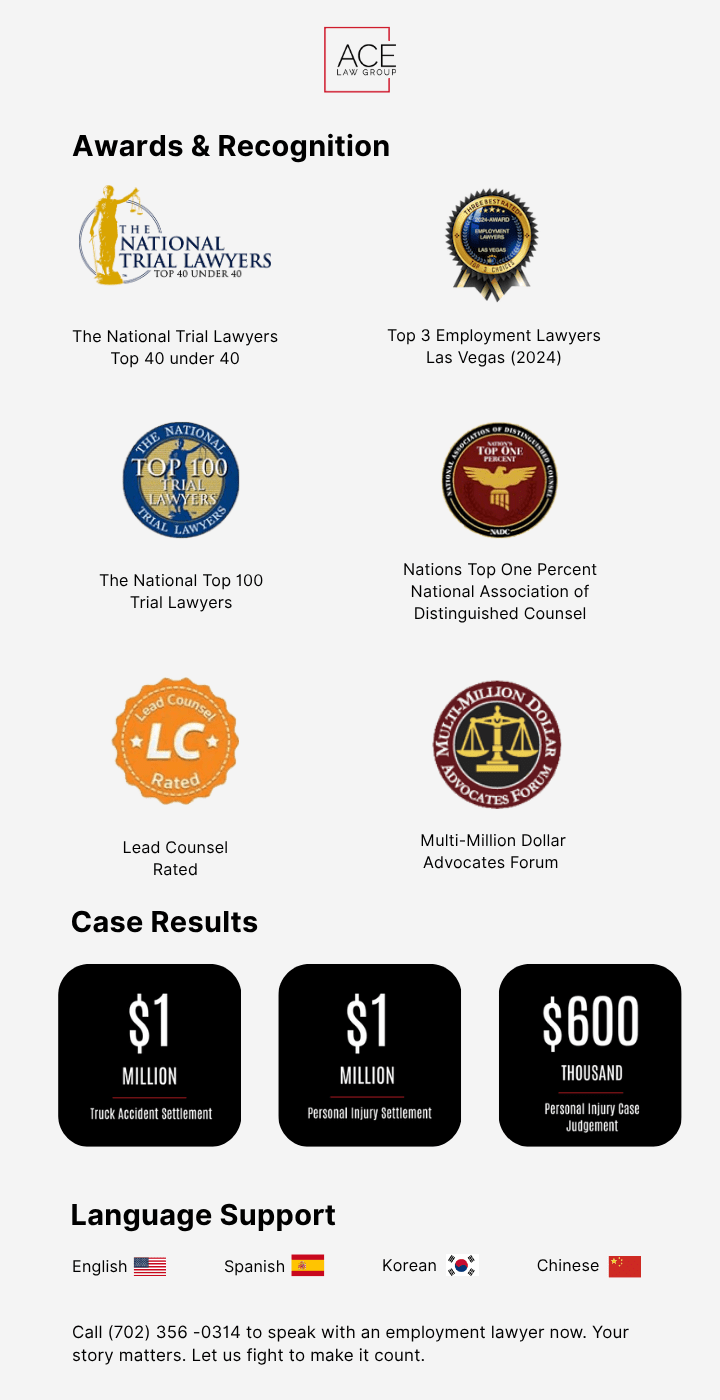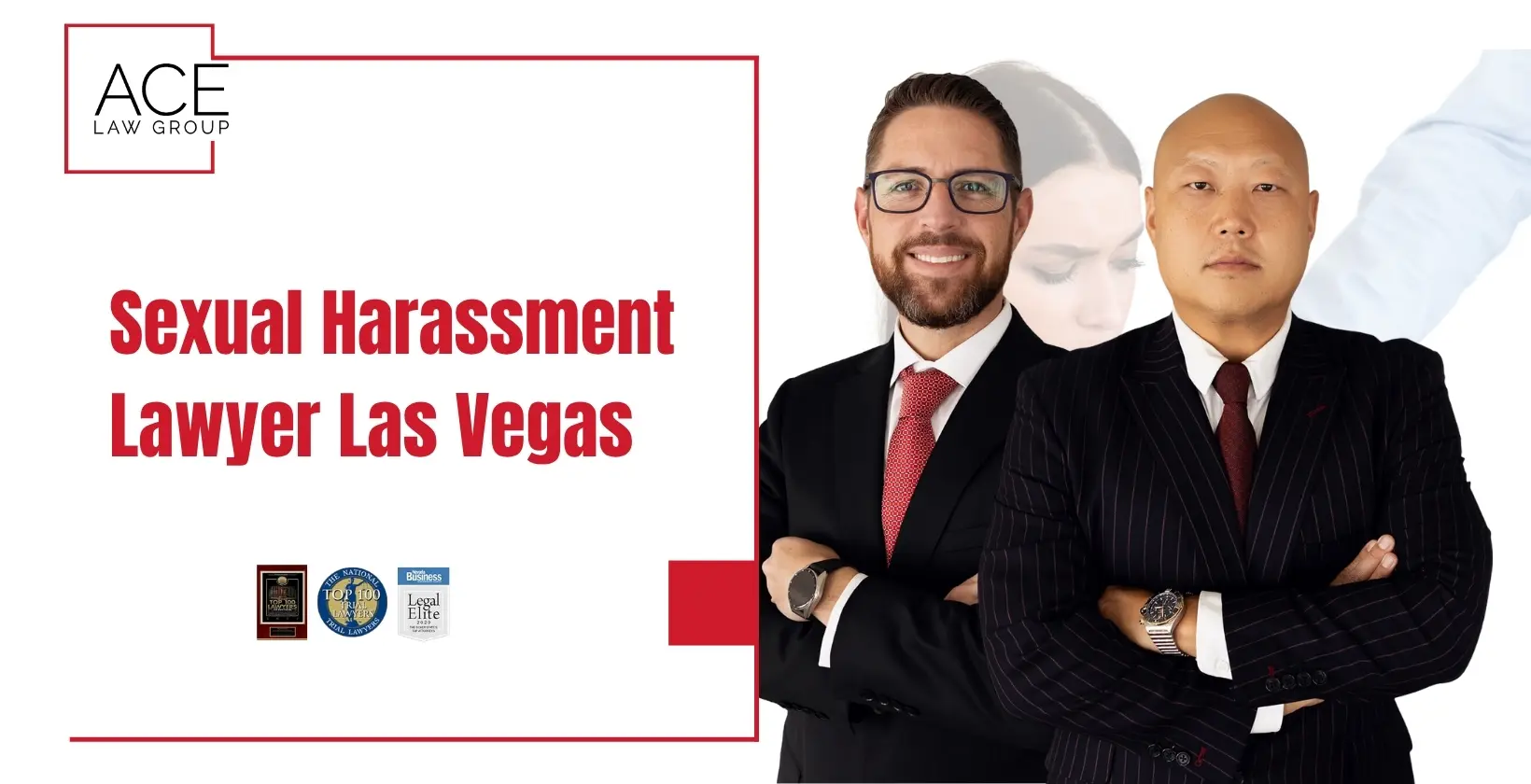When you’re facing harassment at work, it’s easy to feel powerless, but what you write down can become your strongest form of protection. In Las Vegas, a well-documented record isn’t just helpful, it’s often the foundation of a successful legal case. That starts with writing down what happened, when it happened, and who was involved. No legal jargon. Just clear, consistent facts.
At Ace Law Group, we have helped employees across Nevada hold employers accountable by building strong, detailed records, one entry at a time. We know what counts as proof, what HR tends to ignore, and how to transform your private notes into genuine legal authority.
Call us today at 702-356-0314 or schedule your free consultation online. Start protecting your rights. It begins with your words.
Key Takeaways
- Documentation serves as legal proof when it clearly shows what happened, when it happened, and who was involved.
- Writing in neutral, factual language enhances credibility and helps your report withstand scrutiny in legal or HR reviews.
- Federal and Nevada laws protect you from retaliation when you report harassment in good faith.
- Working with a Las Vegas workplace harassment lawyer ensures your records meet legal standards and support a stronger claim.

Step-by-Step Process to Legally Document Workplace Harassment
Writing things down is not enough. How you document harassment matters just as much as what you document. Emotional, vague, or inconsistent notes often get dismissed by HR or carry little weight in legal claims. To be useful in court or during a settlement, your documentation must be structured, neutral, and complete.
Below is a clear, step-by-step method that helps protect your rights, strengthens your claim, and ensures your report is hard to ignore.
Step 1: Record the Date, Time, and Location
Write down the incident on the same day it happens. Note the exact time and location, whether it occurred in a break room, during a Zoom call, or near your workstation. These details create a clear timeline for investigators, reducing doubt about when and where the harassment occurred.
Step 2: Identify All People Involved
List the full names, job titles, and departments of anyone involved, including witnesses. Be clear about who said what or who observed what. Avoid vague references like “someone” or “a manager.” The more specific your list, the easier it is for your lawyer or HR to confirm your account.
Step 3: Log Details Immediately After Each Incident
Don’t wait to document what happened. Details fade fast, and delays can make your story seem less credible. Use a personal journal, a secure notes app, or email yourself the entry while it’s still fresh. Time-stamped notes ensure consistency and maintain the integrity of your timeline.
Step 4: Save Emails, Messages, and Screenshots
Keep every piece of written evidence: texts, DMs, emails, or internal chats. Take screenshots of anything that might be deleted. Store your files on a secure personal device or encrypted cloud account, not your work computer. These digital records form a time-stamped chain of proof.
Step 5: Store Copies in a Safe and Private Location
Never store your records on your work devices or company email. Use a private USB drive, personal laptop, or secure online storage. This protects your privacy and prevents others from deleting, tampering with, or accessing your records without your knowledge.
Step 6: Use Factual, Objective Language Only
Focus on what was said or done, not how it made you feel. For example, instead of writing “She embarrassed me,” say: “She said, ‘You don’t belong here,’ in front of three coworkers.” This makes your documentation more credible and legally useful. Emotional language without facts weakens your report.
Why Documenting Workplace Harassment Strengthens Legal Claims
In any harassment case, documentation is the difference between an allegation and legal proof. When you record each incident clearly and consistently, you create a timeline that lawyers, investigators, and courts can rely on.
This written record shows patterns. It confirms what happened, when it happened, and who was involved. Most importantly, it shifts responsibility from you to your employer, especially if they were informed and failed to act.

Your documentation becomes even more powerful when your employer ignores or mishandles your report. It can serve as proof of negligence or retaliation, both of which add legal strength to your claim and may increase your compensation.
Our workplace harassment lawyers know how to utilize that documentation to build stronger cases and achieve more favorable outcomes. Let us help you document it right from the start.
What Details Make Harassment Documentation Legally Valid
Writing down what happened at work is a strong first step, but not all notes hold up in court. For HR, attorneys, or a judge to take your documentation seriously, it must follow a clear structure and stay completely factual. Emotional summaries or vague wording can weaken your report, even when your experience is real.
Well-documented entries build trust and credibility. When your harassment log includes the right information, in the right format, it stops being a personal journal and becomes legally usable evidence. Here’s how to make that happen.
Five Elements Every Valid Report Must Include
Every strong incident report includes these five essential facts. Without them, your claim may be considered incomplete:
- Who was involved: List full names and job titles of everyone present, both participants and witnesses.
- What exactly happened: Use clear, direct language. Stick to actions and exact quotes, no opinions or assumptions.
- When it occurred: Record the exact date and time. Specificity helps prove patterns and timelines.
- Where it happened: Identify the location clearly, like “conference room,” “Zoom call,” or “break room.”
- Witnesses present: Include any coworkers who saw or heard the incident. Their names add weight to your report.
A consistent format strengthens your claim and prevents disputes, and your documentation becomes much harder to challenge if every report includes these five points.
What Not To Include: Opinions, Speculations, Or Hearsay
Leaving out the wrong things is just as important as including the right ones. Keep your report focused on facts you directly experienced.
- Emotional statements like “I felt disrespected” weaken the factual tone.
- Guesses such as “He probably meant to…” introduce speculation.
- Secondhand accounts like “Someone told me she said…” are considered hearsay.
- Exaggerations or loaded words (e.g., “It was the worst thing ever”) hurt credibility.
- Commentary like “HR never does anything” turns documentation into a complaint instead of a record.
These can weaken your report and turn it into a personal complaint, rather than legal documentation.
How To Structure An Incident Report For Legal Admissibility
A clear, well-structured incident report makes it easier for HR, attorneys, or agencies to review and take action. Stick to objective details and organize your notes in a professional format. Here’s an example layout you can follow:
- Date/Time: May 18, 2025 – 10:45 AM
- Location: Warehouse break area
- Incident: The supervisor yelled, “You’re useless,” in front of two coworkers.
- Witnesses: Witness 1, Witness 2
- Impact: Distracted the rest of my shift, felt uncomfortable continuing work.
This simple format creates consistency across all entries. It also helps the EEOC process your claim faster and take it more seriously.
At Ace Law Group, we help clients document incidents that hold up under real legal scrutiny. If you are unsure whether your report is strong enough, we will review it for free and help you strengthen it if needed.
Common Mistakes Employees Make When Documenting Harassment
Incorrect documentation weakens your case, even if your claim is valid. One unclear entry, a missing name, or emotional wording can give HR or the other side’s attorney an excuse to ignore or challenge your report.
Here are six avoidable mistakes that can weaken your documentation and reduce its legal value:
- Leaving out key details: Missing names, dates, or locations makes your report incomplete and unreliable.
- Using emotional or judgmental language: Words like “rude,” “hostile,” or “mean” shift the tone from factual to personal.
- Waiting too long to write it down: Time gaps create memory gaps. Courts value consistency over delay.
- Only reporting the worst incidents: Harassment often builds over time. Leaving out “minor” events makes it harder to prove a pattern.
- Saving records on work devices: Your company controls those systems. Files can be accessed or deleted without your knowledge.
- Writing erratic entries: If each report is formatted differently, it can look unprofessional or even dishonest.
These missteps are easy to avoid, and fixing them early can make the difference. Clean, consistent, fact-based documentation gives your claim legal strength and gives your attorney a solid foundation to build on.
What Types of Workplace Harassment Should You Document?
Workplace harassment doesn’t always look the same. It can be obvious or subtle, verbal or physical, and come from coworkers, supervisors, or even clients. Each type has a different legal weight, and knowing what you’re experiencing helps you document it correctly and take action that holds up under the law.
Here are four types of harassment that should always be documented:
|
🔞 Sexual Harassment Unwanted sexual comments, jokes, gestures, touching, or advances, whether in person, by text, or online. ➡️ What to document: Time, place, names, and exactly what was said or done. |
🧑💼 Verbal Abuse and Bullying Name-calling, yelling, intimidation, or repeated insults from a coworker or supervisor if they interfere with your ability to work. ➡️ What to document: Who said what, when, and how it affected your performance or mental state. |
|
⚖️ Discrimination and Unequal Treatment Being passed over for promotions, paid less, or disciplined unfairly because of your race, gender, religion, age, or disability is discrimination. ➡️ What to document: Unequal treatment tied to protected characteristics, how others were treated in similar situations, and who made those decisions. |
🚫 Retaliation After Complaints Retaliation is illegal, even when it takes subtle forms. These forms of retaliation, such as exclusion or demotion, should be documented immediately. ➡️ What to document: The date of your original complaint and what changed afterward. |
Every type of harassment has legal implications, but only if it’s properly documented. These patterns matter, and our award-winning employment lawyers help employees across Nevada turn raw notes into real legal action.
What Legal Protections Exist for Employees Who Report Harassment?
Many employees stay silent out of fear. Fear of losing their job. Fear of being labeled a troublemaker. Fear of being retaliated against for doing the right thing. We have seen how often that fear keeps people from filing harassment reports, even when they have every legal right to speak up.
Both federal and Nevada laws make it illegal for your employer to retaliate against you for reporting workplace harassment in good faith. Even if the investigation does not lead to discipline, you are still protected just for making the report.
Retaliation Laws Under Title VII
Title VII of the Civil Rights Act of 1964 protects employees from being fired, demoted, harassed, or penalized for reporting harassment or taking part in a related investigation. These protections apply even if your complaint is later dismissed, as long as it was made in good faith.
Your documentation becomes even more critical if your employer retaliates after you report harassment. That same record can help prove retaliation and support legal claims for reinstatement, back pay, or damages.
Whistleblower Protections and Your Right to a Safe Workplace
Whistleblower laws protect workers who report internal misconduct, such as harassment, discrimination, or illegal behavior, from being punished, isolated, or terminated. These laws apply across various industries, including hospitality, healthcare, construction, retail, and others.
Your protection becomes even stronger when your report involves a legal violation, even if you do not plan to sue. You do not need to be a lawyer to speak up. You just need to document clearly and report what happened.
Legal Action if Retaliation Occurs After Documentation
Retaliation claims often arise when an employee is demoted, excluded, written up, or has their hours cut after filing a harassment report. In many cases, this type of claim can be even stronger than the original complaint.
You can file with the EEOC or the Nevada Equal Rights Commission, and depending on your case, you may qualify for compensation or reinstatement.
Our experienced lawyers build retaliation cases every day. When your employer crosses the line, your documentation gives us the leverage to fight back and win.
Why You Need a Workplace Harassment Lawyer to Document & Strengthen Your Case
Even strong documentation can lose its power if it’s not used correctly. A workplace harassment lawyer does not just file paperwork; we make sure your case is solid from day one. Our experienced attorneys help employees take control by guiding them step-by-step through documentation, legal strategy, and protection from retaliation.
We don’t just build cases. We help you protect your job, your rights, and your future.

When you work with Ace Law Group, you are not alone in the process. You gain an advocate who knows how to transform your documentation into legal leverage that yields results.
Why Hire Ace Law Group For Your Employment Case
When your job, income, or safety is on the line, you need more than advice; you need a law firm that delivers results. Ace Law Group is one of the top-rated employment law firms in Las Vegas, trusted by workers across Nevada for harassment, discrimination, and retaliation claims.
We’ve earned national recognition and delivered verdicts and settlements that change lives.

We do not just know employment law, we know how to win cases that protect your rights and your future. Our firm offers personalized support, proven legal strategy, and full transparency. You do not pay us unless we win for you.
Speak With A Lawyer From Ace Law Group About Your Workplace Harassment Claim
You don’t have to face workplace harassment alone. Our employment lawyers will listen, protect your privacy, and guide you through every legal step, starting with how to document each incident the right way.

Consultations are free and fully confidential. You’ll speak directly with a Las Vegas workplace harassment attorney who knows how to protect your rights at work.
Start Your Case Now!
📞 Call 702-707-8917.
💬 Or schedule your free consultation online today!